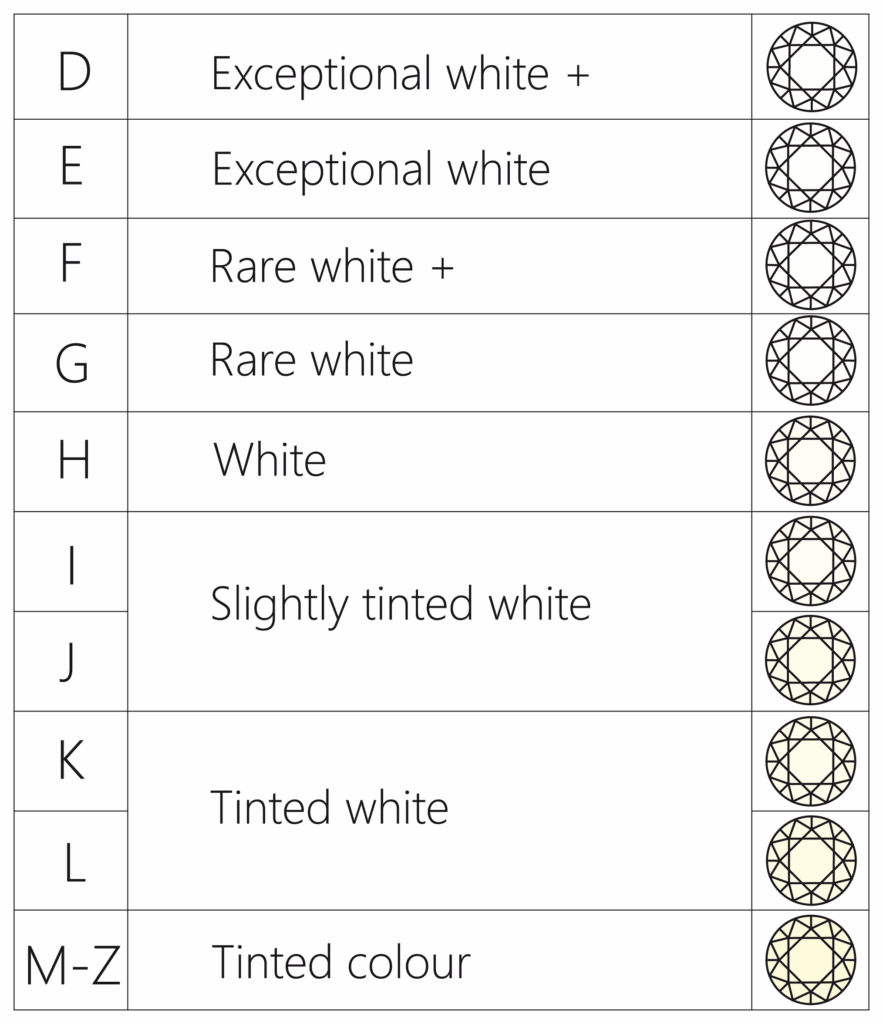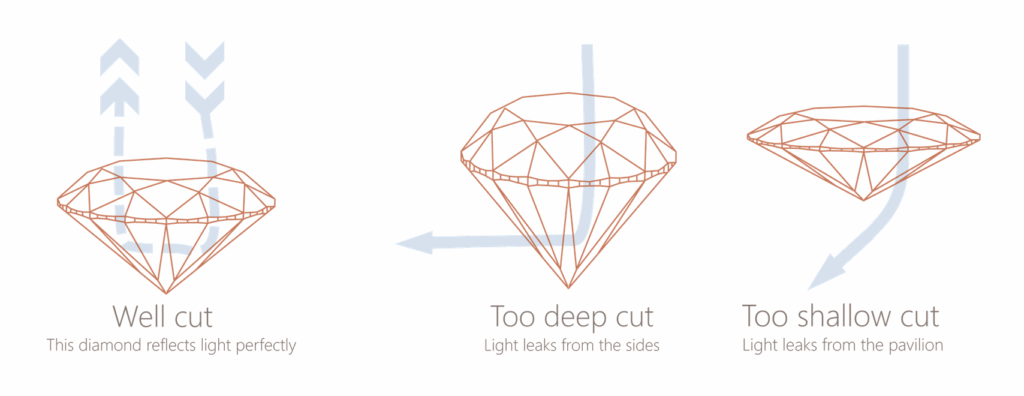Introduction to the 4C’s
Most people compare carat weight to size. The larger the diamond the more it weighs. The weight of a diamond is expressed in carats. The word carat originated from the carob tree or Ceratonia siliqua. The tiny seeds of this tree are well known for their uniformity and consistent weight. Traditionally diamonds and gemstones were weighed against these seeds until the system was standardized, and one carat was fixed at 0.2 grams.
One carat is divided into 100 points. A diamond weighing one quarter of a carat can also be described as weighing 25 points or 0.25 carats. Points are generally not used to describe weights over one carat.

The best color is no color. Diamonds allow light to be reflected and dispersed as a rainbow of color. This light dispersion, or color flash, has no effect on the technical grading of color. The absolute finest colorless stone carries a D rating, descending through each letter of the alphabet to Z, designating a diamond of light yellow, brown, or gray. This body color may be caused by the presence of trace elements, such as nitrogen, within the atomic framework of the carbon crystal. These trace elements are so minute that they are scientifically measured in parts per million (ppm).
As the body color becomes more intense, the grade for color descends the scale. These gradations are so minute and precise that discerning a single grade (even by an expert) under less than ideal laboratory conditions is extremely difficult. It is always best to compare diamonds graded by either the Gemological Institute of America (GIA) or the American Gem Society (AGS), the Hoge Raad voor Diamant (HRD), the International Gemological Institute (IGI) for accurate color grading. When directly comparing diamonds for color, most consumers are unable to detect a difference unless they are at least two or three color grades apart. We recommend selecting a diamond with a color grade of J or better.

Almost all diamonds contain very tiny natural birthmarks known as inclusions. To determine a diamond’s clarity, an expert views it under 10 power magnification. In addition to internal inclusions, surface irregularities are referred to as blemishes. These two categories of imperfections-inclusions (internal) and blemishes (external)-make up clarity.
The fewer the imperfections, the rarer and more valuable the diamond. Many inclusions are not discernable to the naked eye and require magnification to become apparent. A laboratory-certified clarity rating of SI2 represents the point at which inclusions are technically not apparent to the average naked eye.
Contrary to popular belief, higher clarity does not always mean more beautiful. If the inclusions are not visible to the naked eye, a higher clarity does not really improve the appearance of a diamond but rather the rarity and price. A higher clarity is more desirable and valuable, but knowing that you have selected the right clarity for the right reasons is most important. We recommend a clarity of SI2 or better.
Clarity is graded using a very precise and complex method of evaluating the size, location, and visibility of inclusions:

The cut of a diamond refers to its proportions. Of the 4C’s, the cut is the aspect most directly influenced by man. The other three are dictated by nature. Quite often the cut of a diamond is confused with its shape. Diamonds are cut into various shapes depending upon the original form of the uncut diamond, which is referred to as “rough.” Whatever the shape, a well-cut diamond is better able to reflect light.
A diamond’s ability to reflect light determines its display of fire and brilliance. Diamonds are usually cut with 57 facets, or separate flat surfaces. These facets follow a mathematical formula and are placed at precise angles in relation to each other. This relationship is designed to maximize the amount of light reflected through the diamond and to increase its beauty.
– Ideal
This range is very strict and combines the best in brilliance and fire. Technically, the head of the class.
– Excellent
This range is also of great beauty yet slightly more flexible regarding percentages. Many experts prefer the appearance of this range to Ideal.
– Very Good
This range is balanced between precise proportions and price considerations. Viewed by many as the best overall value in beauty and price.
– Well cut (Good)
When a diamond is cut to proper proportions, light is reflected from one facet to another and then dispersed through the top of the stone.
– Deep Cut (Fair-Poor- Unusual)
When the cut of a diamond is too deep, some light escapes through the opposite side of the pavilion.
– Shallow Cut (Fair-Poor- Unusual)
When the cut of a diamond is too shallow, light escapes through the pavilion before it can be reflected.


